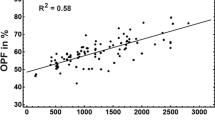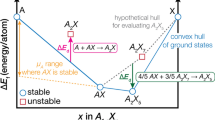Abstract
Employing the n-body potentials of the Ni–Zr and Ni–Ti systems, we performed molecular dynamics simulation to study the relative stability of the terminal solid solutions versus the corresponding amorphous states as a function of solute concentrations. The terminal solid solutions transformed into amorphous states spontaneously when the solute concentrations were beyond the maximum allowable values; i.e., the critical solubilities were determined to be 14 at.% Zr in Ni and 25 at.% Ni in Zr for Ni–Zr system and 38 at.% Ti in Ni and 15 at.% Ni in Ti for the Ni–Ti system. The physical implication of the critical concentrations, as well as their correlation with the glass-forming abilities of the Ni–Zr and Ni–Ti systems, is discussed.
Similar content being viewed by others
References
P. Duwez, R.H. Willens, and W. Klement, J. Appl. Phys. 31, 1136 (1960).
R.B. Schwarz and W.L. Johnson, Phys. Rev. Lett. 51, 415 (1983).
B.X. Liu, W.L. Johnson, M-A. Nicolet, and S.S. Lau, Appl. Phys. Lett. 42, 45 (1983).
T. Egami and Y. Waseda, J. Non-Cryst. Solids 64, 113 (1984).
B.X. Liu, D.Z. Che, Z.J. Zhang, S.L. Lai, and J.R. Ding, Phys. Status Solidi A 128, 345 (1991).
P.R. Okamoto, N.Q. Lam, and L.E. Rehn, Solid State Phys. 52, 1 (1999).
B.X. Liu and O. Jin, Phys. Status Solidi A 161, 3 (1997).
R. Bormann and R. Busch, J. Non-Crys. Solids 117–118, 539 (1990).
Q. Zhang, W.S. Lai, and B.X. Liu, Phys. Rev. B 59, 13521 (1999).
C. Massobrio, V. Pontikis, and G. Martin, Phys. Rev. B 41, 10486 (1990).
R. Devanathan, N.Q. Lam, P.R. Okamoto, and M. Meshii, Phys. Rev. B 48, 42 (1993).
W.S. Lai and B.X. Liu, J. Phys. Condens. Matter 12, L53 (2000).
M. Parrinello and A. Rahman, J. Appl. Phys. 52, 7182 (1981).
Z. van den Beukel and S. Radelaar, Acta Met. 31, 419 (1983).
J. Bøttiger, K. Dyrbye, K. Pampus, and R. Poulsen, Philos. Mag. A 59, 569 (1989).
T. Fukunaga, W. Watanabe, and K. Suzuki, J. Non-Cryst. Solids 61&62, 343 (1984).
F.A. Lindemann, Phys. Z. 11, 609 (1910).
M. Born, J. Chem. Phys. 7, 591 (1939).
T. Minemura, J.J. van den Broek, J.L.C. Daams, J. Appl. Phys. 64, 4770 (1988).
P.R. Okamoto, J.K. Heuer, N.Q. Lam, S. Ohnuki, Y. Matsukawa, K. Tozawa, and J.F. Stubbins, Appl. Phys. Lett. 73, 473 (1998).
Author information
Authors and Affiliations
Corresponding author
Rights and permissions
About this article
Cite this article
Lai, W.S., Liu, B.X. Glass-forming ability of the Ni–Zr and Ni–Ti systems determined by interatomic potentials. Journal of Materials Research 16, 446–450 (2001). https://doi.org/10.1557/JMR.2001.0067
Published:
Issue Date:
DOI: https://doi.org/10.1557/JMR.2001.0067




